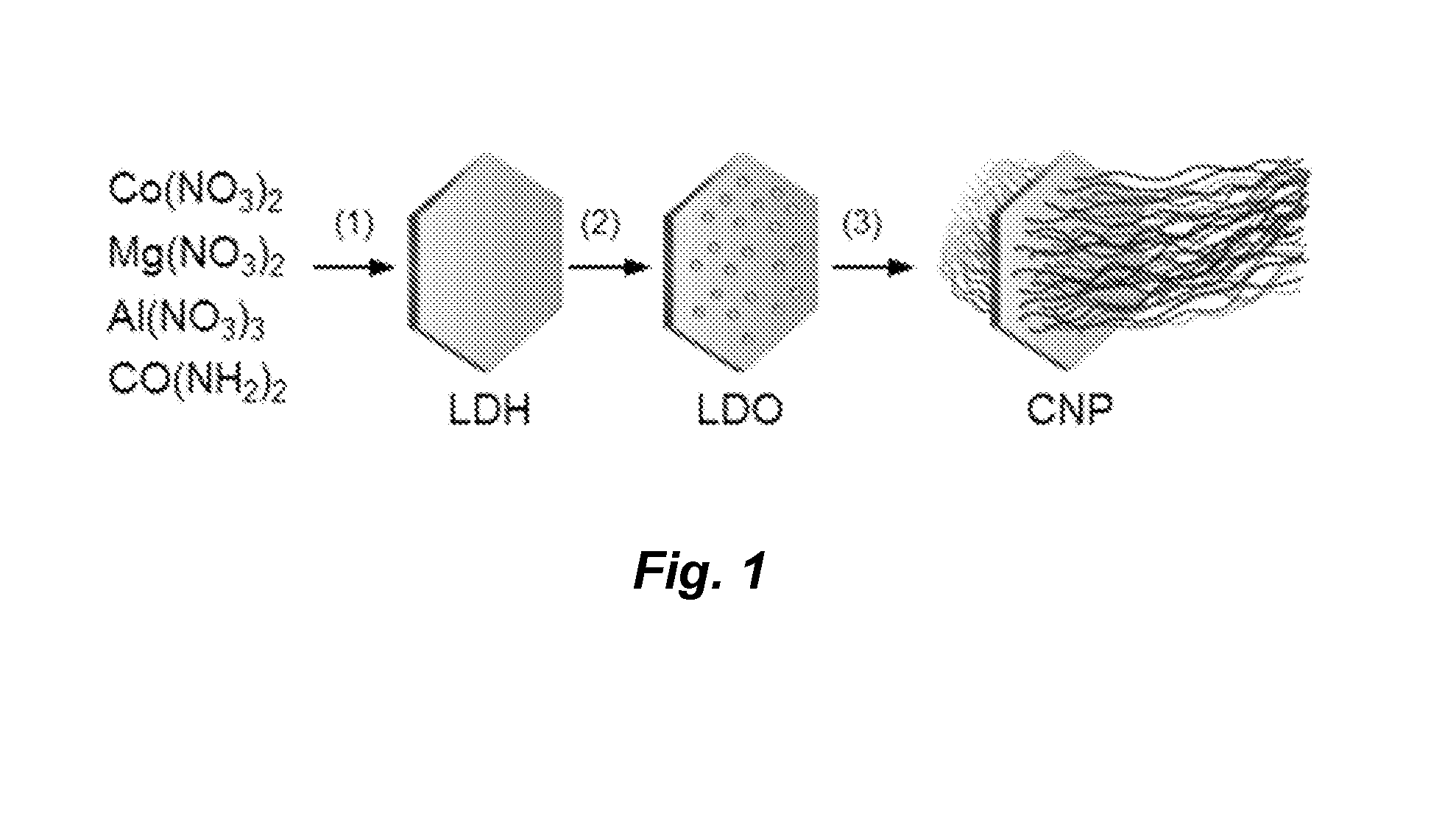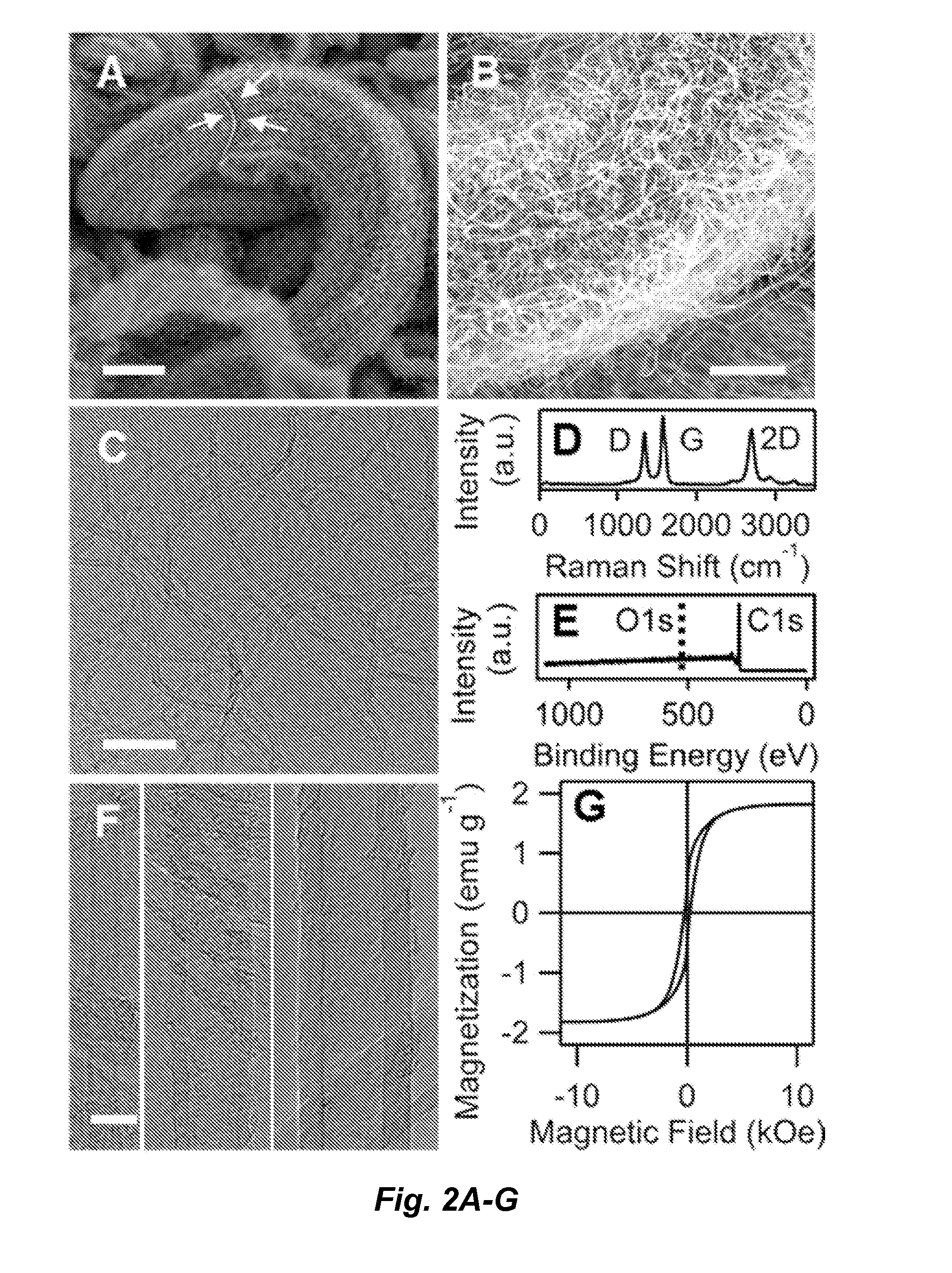Carbon nanotube ponytails
a technology of carbon nanotubes and ponytails, which is applied in the direction of catalyst activation/preparation, metal/metal-oxide/metal-hydroxide catalysts, etc., can solve the problems of not being able to settle well under gravity, not being able to achieve the effect of gravity separation
- Summary
- Abstract
- Description
- Claims
- Application Information
AI Technical Summary
Benefits of technology
Problems solved by technology
Method used
Image
Examples
example 1
Synthesis of Carbon Nanotube Ponytails
[0101]Nitrate salts of aluminum, magnesium, and cobalt were mixed with urea in 100 mL deionized (DI) water (Millipore). The final concentrations of the precursor ingredients were 100 mmol L−1 for urea and 50 mmol L−1 for all metals: α% for Co, (67−α)% for Mg, and 33% for Al with a being varied from 5 to 33%. The solution was placed in a sealed autoclave reactor and heated to 100° C. After a period of time (typically 12 hours), layered double hydroxide (LDH) discs were produced. LDH discs were collected by centrifugation, washed with DI water, and calcined at 800° C. in air for 20 minutes. LDH discs were then placed inside a sealed quartz tubing and heated by a tube furnace to 800° C. under argon protection. Hydrogen was passed through the tubing at 50 sccm for 5 minutes to reduce LDH to LDO. Ethanol was then supplied by bubbling argon through a reservoir at 100 sccm for 15 minutes to grow CNT arrays on LDO discs.
example 2
Synthesis of Unbounded Carbon Nanotubes
[0102]Unbounded CNTs used to compare with CNPs in gravitational settling were prepared using a powder catalyst consisting of cobalt, molybdenum, and magnesium. Wang et al., Removal of Oil Droplets from Contaminated Water Using Magnetic Carbon Nanotubes. Water Res. 2013, 47, 4198-4205. The growth of CNTs using CVD followed the same procedure as described above except that the powder catalyst was used instead of LDO discs. After 15 minutes of CVD growth, the powder catalyst was dissolved away by soaking CNTs in concentrated hydrochloric acid at 80° C. for 8 hours. The remaining CNTs were cleaned with DI water and freeze-dried (Labconco). The unbounded CNTs have similar morphologies and surface properties as the individual CNTs in CNPs, as described in more detail below.
example 3
Preparation and Evaluation of Pd-Decorated CNPs
[0103]Nanoparticle decoration was achieved using a one-step protocol by mixing Pd(NO3)2 solution with CNPs. He, H. K.; Gao, C., A General Strategy for the Preparation of Carbon Nanotubes and Graphene Oxide Decorated with PdO Nanoparticles in Water. Molecules 2010, 15, 4679-4694. 10-mg CNPs were mixed with 20 mL DI water in a 50 mL flask under sonication. Twenty milliliters of Pd(NO3)2 solution (5 mM) were added to the flask drop by drop under magnetic stirring. The mixture was permitted to react for 30 minutes to form PdO nanoparticles on CNPs. PdO-CNPs were collected using an external magnetic field and washed repeatedly with DI water. The washed PdO-CNPs were re-dispersed in 40 mL water under sonication. PdO-CNPs were reduced to Pd-CNPs by mixing with sodium borohydride solution. The composition of PdO-CNPs was determined by dissolving the composite in concentrated nitric acid and measuring the Pd content using inductively coupled pla...
PUM
| Property | Measurement | Unit |
|---|---|---|
| Length | aaaaa | aaaaa |
| Length | aaaaa | aaaaa |
| Fraction | aaaaa | aaaaa |
Abstract
Description
Claims
Application Information
 Login to View More
Login to View More - R&D
- Intellectual Property
- Life Sciences
- Materials
- Tech Scout
- Unparalleled Data Quality
- Higher Quality Content
- 60% Fewer Hallucinations
Browse by: Latest US Patents, China's latest patents, Technical Efficacy Thesaurus, Application Domain, Technology Topic, Popular Technical Reports.
© 2025 PatSnap. All rights reserved.Legal|Privacy policy|Modern Slavery Act Transparency Statement|Sitemap|About US| Contact US: help@patsnap.com



